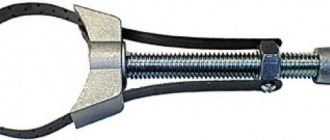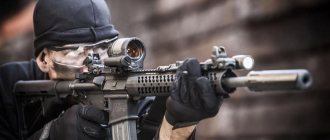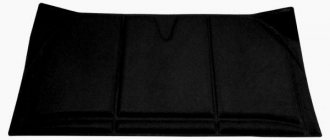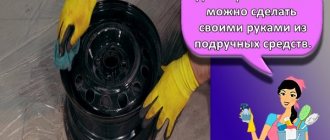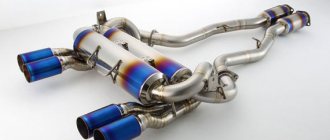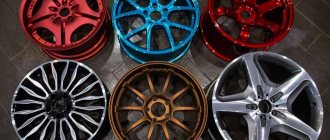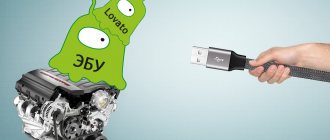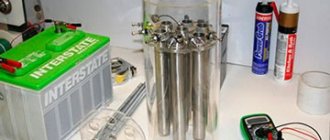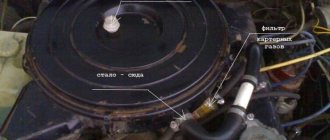Full sound insulation of the rear and front wheel arches of the car can significantly reduce the noise penetrating into the cabin from the suspension and chassis. High-quality vibration insulation of the inner surface of the arches, sound insulation of the interior floor and trunk is the only reliable method to increase the comfort of the car and create additional anti-corrosion protection in the area of the body where sand, dirt and road reagent flow from under the wheels. In addition, the plastic protective fender liners, when worn out at the fastening points, come off and begin to rattle like a tin can suspended from the body. Reliable sound insulation also helps to get rid of this disadvantage.
Materials used in work
First, we’ll explain what materials are needed to make sound insulation for the arches and fender liners:
- To create an effective noise-insulating layer, you can use different technologies
- If you did not have additional plastic fender liners installed in your car, then the technology of applying a soundproofing layer directly to the metal surface of the arches is used (see Soundproofing car arches with different materials)
Soundproofing the fender liner yourself is a completely accessible operation; first, let's decide on the materials:
Vibration damper
So:
- Vibroplast is the first layer - for example, Bimast Bomb, this vibration damper has the highest mechanical loss coefficient when compared with most other similar materials
- Bimast Bomb has a CMP of 0.4 units
- This material perfectly adds rigidity to any structure processed by it, this allows it to be used not only in the process of complete sound insulation of cars, it is excellent for acoustic preparation of any car
- Bimast Bomb is a material that has a bitumen-mastic base, its top layer is metalized, and the bottom layer is made self-adhesive, it is covered with a special protective layer
- However, when installing this material, it is necessary to preheat it with a hairdryer in one of two ways:
- In the first method, the protective layer is first removed, and the material is laid upward with a sticky layer on a clean surface.
- Then, using a hairdryer, you need to evenly heat its adhesive surface until a shine appears, but there is no need to bring it to a boil.
- Then the heated soundproofing material is turned over and glued to the surface designated for it; after application, it is quickly rolled out using a mounting (hard) roller
Soundproofer
Splen can be used as a second or third layer on top of vibration insulation - Splen today is one of the most popular materials in the field of car sound insulation:
- This popularity is explained by several obvious reasons, the first of which is the low price.
- Since Splen is a sound insulator, it turns out that it reflects (repels) the incoming sound wave
- Therefore, it is quite suitable for insulation from the outside, but it is better to use Accent from the inside for sound insulation
- It is not worth gluing it as the first layer
- Much more effective is the Splen sticker on sound-absorbing and vibration-absorbing material
- In addition, Splen is an excellent heat insulator
- Therefore, for the purpose of thermal insulation, it can be laid as a third layer on top of vibration and noise insulation
- It has long been noticed that a car covered with Spleen from the inside retains heat better, which is especially noticeable in the winter.
- A big plus in harsh Russian winters in some northern regions
- The presence of its own adhesive layer makes working with Splen a pleasure
- It “tightly” sticks to the selected surface
- To achieve the greatest effect, you need to cover the entire treated area with sheets of maximum size.
- It is necessary to ensure that the number of joints is minimal, do not glue Splen in small pieces
Liquid sound insulation
Liquid SHVI is mainly used for processing external arches and the bottom of a car:
- Since sheet sound insulation is not entirely suitable for treating these parts of the car, since it does not cope well with the influence of the external environment
- Since the vast majority of all insulating materials quickly or slowly absorb moisture
- In addition, they are exposed to the decomposing effects of chemicals, temperature changes, as well as other destructive factors, so after a while they begin to peel off and cease to resist corrosion and extraneous sounds. The use of mastic materials will allow you to more reliably protect the exterior surfaces of the body
- All liquid sound insulation materials satisfy a range of much-needed requirements
- They withstand operating temperatures, are resistant to salt reagents (which are so fashionable to sprinkle on roads in winter), resistant to flying gravel, as well as small stones
- The main component of mastic materials is liquid rubber, which, after drying, becomes a dense layer of substance that effectively protects the entire treated surface from all sorts of harmful influences.
- Additionally, it is an anti-corrosion agent, plus it has a noise-insulating effect.
- It is also called liquid fender liners, of course it is best to use comprehensive protection
External method
External sound insulation is the most common option because it is simple and does not require special tools.
The work order is as follows:
- Jack up. Remove the wheel.
- Remove the locker, if present. A locker is a fender liner, usually made of plastic, less often of metal. It is used to protect the metal arch from salt, acid, reagents, and pebbles.
- Remove factory installed sound insulation.
- Remove the anti-corrosion coating, also factory-made.
- The surface of the arch is cleaned and degreased, for example with white spirit.
- Stick the vibration damper over the entire area.
- Glue the foil splen. This is at your discretion, if desired. This is a plastic self-adhesive soundproofing material.
If you want to additionally stick a self-adhesive sticker made of splen foil, then it is better to buy it with a thickness of at least 8 mm.
To prevent the appearance of corrosion on the wing arch, it is necessary to treat noise-free surfaces with an anticorrosive agent. I usually use rubber-based mastic for this purpose.
How to store tires? It turns out that there are rules here too, if you follow them, the quality of the rubber will remain close to the factory one.
Soundproofing of the engine compartment
The best effect in reducing engine noise is achieved when sound insulation of the engine compartment is done both from the interior and from the outside.
This process is perhaps the most difficult compared to working on other parts of the body. The main difficulty is disassembling the instrument panel. Because modern cars have a lot of electrical equipment, which is located in the dashboard area. Therefore, the process of removal and reassembly will require very great care and attention. Also, you need to take into account that it is unlikely that it will be possible to soundproof the engine in one day.
On the engine compartment side, it is advisable to use thicker vibration insulation; it would not be a bad idea to use a material that requires heating. You need to cover the maximum area, including the most inaccessible places. A material with a reflective surface is suitable for sound insulation in order to prevent possible overheating.
On the interior side, the thickness of the materials is chosen so that the dashboard fits into place.
If all work is carried out correctly, the noise level from the engine in the cabin will decrease significantly (up to 50%). Vibrations will also be reduced, which can be felt on the steering wheel. In addition, if during assembly you use a material such as modelin, etc., then you can get rid of creaks and annoying “crickets” in the dashboard, if there were any.
The main disadvantage is the risk of damaging expensive equipment. It often happens that after soundproofing the instrument panel, failures in the electronics are observed.
Therefore, before deciding to carry out this work, you need to weigh everything carefully.
Why do they do soundproofing?
When the car moves, body parts vibrate. There is also quite a bit of noise coming from the doors, bottom and other elements. Many details, with their vibrations, fall into resonance, worsening the overall picture. The engine and chassis do not contribute to acoustic comfort.
Because constant noise negatively affects not only the comfort of the trip, but also the condition of the driver, and therefore traffic safety; insulation is used to combat it. If it is done properly, then in the cabin, even at high speed, it is not necessary to raise your voice during a conversation. And it’s more pleasant to listen to music. And there is less fatigue at the end of the shift.
Liquid insulators
There are special liquid compounds that can be used to soundproof car wheel arches. The basis of such insulators is rubber. A distinctive feature is the liquid state, which, after application, creates a durable and effective insulating layer on the surface. To process the arches, you will need a special sprayer that will supply the material under high pressure. This method makes it possible to apply the product to the most difficult to reach areas. It takes literally a few hours to completely process the body, and a few minutes is enough for the arches.
Special experience is not a requirement here. The main thing here is to have spraying equipment and a fairly expensive liquid soundproofing material at your disposal. Liquid compositions perform well when applied to internal and external surfaces. To properly apply such an insulating agent, you need to lift the car, remove the wheels, clean and rinse all treated surfaces. It is better to replace White Spirit with a soap solution, which allows you to degrease the metal quite effectively.
Now you need to apply a liquid insulator to the surface. It is applied in layers from 1 to 3. This depends on what technology you will use, as well as what conditions of use the manufacturer himself has provided. Practice has shown that it is not necessary to use special sprayers. Yes, they help distribute liquid soundproofing material more effectively and evenly, as well as reach hard-to-reach areas. But if there is no spray bottle, there is no need to worry. Liquid products are quite easy to apply with regular brushes. Their consistency is more convenient to use than in the case of mastics. At the same time, efficiency is at an extremely high level. But here it is better to take liquid insulators from proven and well-established manufacturers.
Alternative way
In addition to special soundproofing self-adhesive materials, there is another alternative option - liquid fender liners. Based on the principle of creating liquid fender liners, they protect the body along the perimeter at the base and sills with a special substance - gravitex. These are liquid substances, for example, rubber-based mastic, which fills all the unevenness, holes if there are any, and quite effectively protects against noise.
Liquid fender liners are also a very popular option because they are simple and lightweight. They are used to treat wheel arches, the bottom of the car, and the bottom of the trunk.
To apply mastic you need a brush and a sprayer. The sequence of work is the same as in the case of all painting work: wash, clean, degrease and apply mastic in several layers.
Manufacturers' recommendations (different methods)
Floor soundproofing installation diagrams with materials:
| Shvi layer | Material | STP (thickness, mm) | Shumoff (thickness, mm) |
| 1 | Vibration isolation (vibration damper) | StP Aero Plus (3mm) Bimast Bomb Premium (4.2mm) | SHUMOFF L3 (3mm) SHUMoff Mix F (6.2mm) |
| 2 | Sound-absorbing Thermal insulation | Accent Premium (8-10mm) Barrier (10 mm) or Splen (10 mm) | Shumoff P8V (8mm) |
| 3 (optional) | Soundproofing (soundproofing membrane) | NoiseBlock (2mm) | Germeton A30 (3mm) |
Approximate price of materials:
- Budget option (2 layers, thin vibration damper and heat insulator), up to 4,000 rubles.
- Popular option (2 layers, vibration damper and sound absorber), about 4,000 rubles.
- Maximum effect (3 layers of vibration damper, sound absorber and sound insulator), more than 4,000 rubles.
How to make sound insulation for car wheel arches with your own hands
Getting rid of noise on cars without lockers
First, let's consider an option that does not provide for the presence of fender liners (so-called lockers).
Tools and Supplies
- Jack.
- Set of socket heads with a wrench.
- Spray.
- Metal brush.
- Several old newspapers.
- A container with a mastic-type liquid vibration insulator (this can be Dinitrol 479 or Noxudol 3100).
- Container with dishwashing liquid.
Sequencing
- The car is installed above the inspection hole, one of the wheels is jacked up and removed.
- Using a metal brush, the inner surface of the wheel arch is cleaned of dirt and dust, then thoroughly washed with a special product (this is necessary for degreasing).
- Shock absorber springs, brake discs, ball joints and other parts that cannot be painted are carefully wrapped in newspaper.
- After this, vibration-isolating liquid is applied using a sprayer to the entire surface of the arch.
How to properly insulate fender liners from the outside
On some car models, the manufacturer initially installs plastic fender liners. Their main task is to protect the arch from impacts from stones and other foreign objects. But with the help of lockers you can also reduce the noise level produced by tire rubber.
- The car is installed over the pit, the wheels and fender liners are removed, after which the arches are degreased and treated with a liquid noise-absorbing compound according to the method described above.
- The fender liners are also thoroughly cleaned of dirt.
- After this, a vibration-filtering coating (for example, “Vibroplast M1”) is glued to the lockers.
- If the manufacturer provides ventilation holes in the fender liner design, the applied coating in these places is carefully cut out with a knife and removed.
- The lockers covered with a vibration filter are mounted in their standard places.
Insulation of the inner side of the wheel arches
Car owners rarely limit themselves to soundproofing the outer surface of the arches. To make the ride even more comfortable, they also insulate the arch on the other side.
- Access to the arches from the inside is maximized: all components and elements that interfere with further work are removed.
- The surfaces are cleaned and degreased as described above, after which one layer of liquid noise absorber is applied to them.
- As soon as the substance dries, an old newspaper is placed on the surface of the arch, and the contours are outlined with a pencil. A template is created.
- A piece of the required size is cut out of the material in accordance with the template, which is glued to the arch arch.
Soundproofing of arches can be done even by a novice car enthusiast who has at least a vague understanding of metal painting. Modern vibration-absorbing filters are produced with a self-adhesive surface, so there should be no difficulties with their installation
The main thing to pay attention to is degreasing. If the surface is poorly prepared, the sound absorber will quickly begin to peel off and all efforts will go to waste.
Processing procedure
It cannot be said that among all the stages of soundproofing a car, working with arches is the most difficult. Therefore, many people do it with their own hands, since the procedure does not take much time, plus it does not require any special skills. It is recommended to use a combined method of sound insulation using liquid rubber, bitumen mastics and sheet anti-noise products that are glued on top of liquid materials. If the car has fender liners, they can be treated with two-layer foil materials for sound insulation, which are used to protect almost the entire car. This is a basic body insulator used by most automakers during the production phase of the vehicle. To make it easier to soundproof car arches with your own hands, you should separately consider the procedure for interior and exterior finishing.
Internal processing
Let's start with how to properly soundproof car arches from the inside. It is from this stage that you need to start if the car owner wants to achieve maximum results. The procedure looks something like this:
- Preparing the arches. To begin the procedure, the vehicle owner will first have to remove the wheel arch liners, anthers and dismantle the bumper itself. This will allow easy access to all elements of the wheel arches;
- The surface is being processed. At this stage you need to get rid of all contaminants. Approach the cleaning procedure very carefully, since remaining debris and dirt can prevent soundproofing materials from adhering well to the surface. This will reduce the effectiveness of the insulation itself, and also increase the likelihood of the formation of corrosion spots;
- When all contaminants have been removed, the surfaces are degreased. You can use any means suitable for such purposes. Most often, motorists use White Spirit. Cheap and very effective;
- At the next stage, the inner side of the arches is glued with a material like Bimasta. This is the most common insulator, which has proven itself well. An effective sound-absorbing material is also applied. Here many people prefer the Accent product.
How to soundproof the engine and engine compartment
Once all the necessary material and tools have been prepared, it is necessary to prepare the car. To do this, it is necessary to remove all excess from the surface undergoing this procedure. Note that this procedure is very different from soundproofing wheel arches, both in materials and in the procedure itself.
First of all, the hood of the car is soundproofed. For convenience, it is recommended to remove it to avoid certain complications. In the process of attaching layers, it is necessary to follow a number of simple and necessary rules:
First, the hood must be thoroughly cleaned of dust and rust.
Try to pay special attention to this, otherwise the material will not stick and will quickly peel off. Next, use a dry rag to remove moisture from the surface. The first layer is always a vibration-absorbing material
For its pattern, pre-prepared pieces of cardboard are used. Then, the cut layer is applied to the surface and rolled using a roller. This is done to ensure that the material becomes even and sticks over the entire area without the formation of bubbles and loose corners.
Before peeling off the protective film, make sure the dimensions are correct. Otherwise, you risk damaging the material and incurring additional costs. When choosing a material, use only heat-resistant film. The fact is that during engine operation, it gives off a large amount of heat, which can adversely affect the sound insulation and gradually either ruin it or simply peel it off. Be sure to add a layer of foil. This will improve the reflection of heat, protect the sound-insulating layer and increase the speed of warming up the engine in winter.
There is no need to waste material on stiffening ribs. The fact is that such layers can become the main reason for the distortion of the hood itself. At the same time, it will close unevenly, and in some cases it will seriously spoil the aesthetics. If the car had factory sound insulation, it is recommended to use it as the last layer, although it can also be replaced with madeline, which fits perfectly into the design.
Soundproofing of the engine compartment occurs in exactly the same way. But first, all attachments are removed, since they will interfere with both the pattern and the gluing of the layer. As a rule, dismantling the engine is not required, since the motor is installed in the middle and does not interfere with the work. However, many parts of the engine compartment will still have to be dismantled.
Liquid sound insulation
Liquid sound insulation allows you not only to protect the interior from unnecessary sounds, but also to prevent the appearance of rust on the car’s wheel arches.
Installation of such a coating is quite difficult, so it is extremely important to do everything in strict order:
- It is necessary to remove the bumpers and wheels from the car, do not forget to place the car on several jacks.
- The surface of the arches must be treated with a special degreasing solution.
- The noise insulator should be applied in even layers using a sprayer.
- Liquid sound insulation will take some time to dry. After it dries, you need to install additional plastic fender liners.
When installing this sound insulator, extreme care should be taken, since liquid if it gets on the suspension elements can lead to a deterioration in their performance. It is advisable to place cardboard on the suspension parts in advance to protect their surface. Don't forget to wear rubber gloves.
Liquid sound insulation can prevent rust from appearing on wheel arches
Calculation of the quantity of materials
It is not difficult to calculate the required amount of materials for soundproofing a car, but this will require disassembling the interior, trunk, and measuring everything with a tape measure. We offer an easier way. Below is a table with calculations of materials already carried out for different classes of machines. These are, of course, inaccurate indicators, but they are sufficient to understand how much of something will be needed and how much it will cost.
| Car class | Bottom | Trunk | Doors (4 pcs) | Roof | Hood |
| A | B – 3 ZV – 3 | B – 2 ZV – 2 | V – 2.4ZV – 1.5P – 1.5 | B – 3 ZV – 3 | ZV – 2 |
| B | B – 3 ZV – 3 | B – 2 ZV – 2 | V – 2.4 ZV – 1.5 P – 1.5 | B – 3 ZV – 3 | ZV – 2 |
| C | B – 4 ZV – 4 | V – 2.8 V – 2.8 | V – 2.4 ZV – 1.5 P – 1.5 | B – 4 ZV – 4 | ZV – 2 |
| D | B – 4 ZV – 4 | B – 3 ZV – 3 | V – 2.4 ZV – 1.5 P – 1.5 | B – 4 ZV – 4 | ZV – 2 |
| E | B – 4 ZV – 4 | B – 3 ZV – 3 | V – 2.4 ZV – 1.5 P – 1.5 | B – 4 ZV – 4 | ZV – 2 |
| Crossovers | B – 4 ZV – 4 | B – 3 ZV – 3 | V – 2.4 ZV – 1.5 P – 1.5 | B – 4 ZV – 4 | ZV – 2 |
B – vibration-absorbing material;
ZV – sound-absorbing material;
P – cushioning material.
The numbers indicate the amount of material per m2.
If you need to silence the instrument panel, add an extra meter and a half of cushioning material.
Why insulate wheel arches and fender liners?
The main part of the noise present in the interior of a moving car comes from the wheel arch area. It is in this space that many sounds are concentrated: the hum of rubber, the sounds of operating suspension, the knock of road surface particles flying out from under the wheels. And with a low level of noise insulation, all this noise will be very annoying and distracting, reducing the driver’s concentration and increasing his fatigue. The issue of noise reduction of wheel arches is especially relevant in the realities of Russian roads.
Additional insulation of the arches not only reduces the noise level in the cabin, but also has a good effect on the resistance of body elements to corrosion and other negative influences.
It should be understood that simply a separate noise reduction of the arches may not give the desired result. Experts recommend carrying out this work in conjunction with other measures to improve the sound insulation of the car.
Getting rid of noise correctly: video
Getting the maximum positive effect
To achieve the maximum effect from sound insulation, simple instructions will help you:
- If your car does not have plastic fender liners installed, you will need to purchase them
- Then the outside of the arches is cleaned of dirt, as well as factory anti-corrosion (preservation) treatment
- Then a special noise-absorbing composition (such as Noise Liquidator) must be applied to the cleaned and degreased metal, preferably a two-component one.
- Firstly, it copes well with corrosion, and therefore it is no longer necessary to cover the surface with anything else on top of it.
- Liquid sound insulation of arches of Skoda Octavia A5 and other car brands is the best choice
- Then we glue the purchased fender liners with a vibration damper (for example Bimast Bomb) on the side that will be adjacent to the body
- And you can glue Splen on top of Bimast, but this is not at all necessary
- For example, we did not feel any difference from his absence or presence
- Then the pasted fender liners are placed inside the arches
- The standard fastening pistons may not withstand the load because the fender liners have become significantly heavier
- Therefore, it is better to replace them with galvanized screws or stainless steel fasteners
- Before tightening the fastener, it must be dipped in a corrosion-inhibiting compound to prevent rust.
Additionally, you can watch video material on processing and pasting.
Is soundproofing car fender arches effective?
Self-applied soundproofing of the wing arches will fly off over time if this soundproofing cake is not protected. That is, you need to re-attach the fender liners on top of this insulation, if not, buy them. Standard fastening of fender liner pistons. Some people don't trust them because the caps may not withstand different vibrations. Additionally, it can be reinforced with galvanized or stainless steel screws. Self-tapping screws can also be dipped in anticorrosive.
Helpful advice: if there are special holes on the fender liners, then there is no need to seal them with noise. At the end of the article there is a video comparing the effect before installing Shumka and after.
Noise insulation of car wheel arches
When the work is carried out correctly, the interior is reliably protected from wheel noise, falling stones, sand and water.
And if the front arches are separated from the interior by a rear sofa that prevents the passage of sound, the front elements require special attention. Below we will look at how soundproofing of wheel arches is done, what materials are required for this, and what algorithm should be followed.
Why do you need soundproofing for wheel arches?
Many manufacturers skimp on sound insulation, which is why car owners have to modify the car themselves.
If the factory used sound and vibration insulating materials, there most likely will not be any in the wheel arches.
As a result, the impact of stones on plastic, the noise of tires (especially if they are studded), as well as other extraneous sounds can be heard in the cabin.
The noise level depends on the car body and the location of the wheel arches. The closer they are to the cabin, the louder the sound.
When solving problems with extraneous sound, car owners have two options:
• go to a service station or to private craftsmen, spending a certain amount; • buy material for sound insulation of wheels and do everything yourself.
The work is carried out in two directions - soundproofing the wheel arches from the outside and from the inside. For greater effectiveness, both areas need to be treated. In terms of the level of costs, the situation almost changes, but the result is immediately noticeable.
Preparatory work
Soundproofing wheel arches begins with preparatory work.
The car owner must:
1. Choose a place to carry out the planned activities. You will need a warm room with an inside temperature of 20 degrees Celsius and above.
2. Wash the niches of the arches using a special sink. Devices operating under high pressure are used for cleaning. At the initial stage, you need to remove the main plaque and dirt. The rest of the work is done manually after dismantling the interfering elements.
3. Buy a tool (if you don’t have one) for removing wheels and lockers. To work, you need a jack, a bracket, a remover for fasteners and heads for bolts. You also need clean rags and a degreaser (you can use White Spirit). You cannot do without a sharp knife and a roller to press the noise and vibration insulating material.
4. Understand the principle of fastening the fender liners. In some cars they are disposable, so before starting work you need to buy fastenings in advance.
5. Slightly unscrew the bolted connections on the wheels (before raising the machine). For the job, you will need a high-quality rolling jack that can withstand more weight. There should be a flat surface under the bottom of the car that is convenient for attaching sound insulation to the wheel arches.
First you need to decide what to process - wheel arches or locker. For greater efficiency, it is necessary to process the metal, because finishing the fender liner does not give the expected result.
The second solution is suitable for cases where the arches already have sound insulation, and the car owner wants to enhance the effect by treating the lockers.
Material for sound insulation of wheel arches
To obtain the effect, you need to use two types of coating - one that protects from vibrations and one that prevents the penetration of sounds. You should not save on materials, because you may regret it later.
Popular vibration absorbers:
• Vibroplast Gold is a self-adhesive material that is used to soundproof a car. The structure consists of a foil layer, a polymer layer and anti-adhesive paper. Installation is carried out at a temperature of 18-30 degrees Celsius. Pre-cleaning of the surface is required
It is important to avoid bubbles between the body and the material. The product is sold in sheets of thickness 2.3 and 3.2 mm
Size 75*45 cm.
• Vizomat BT is a good material for sound insulation of wheel arches, consisting of several layers (canvas, bitumen, adhesive and protective film). Attaches only to cleaned and dried surfaces at a temperature of 18-30 degrees Celsius. The product is sold in sheets measuring 53*75 cm, quantity 10 units per package.
Sound absorption means:
• Biplast is a reliable material on a self-adhesive film, made of high-quality polyurethane (foam-based). It dampens vibrations and squeaks well. Consists of an adhesive layer, polyurethane foam and anti-adhesive film. Available in several types (5K, 10K and 20K). The product is sold in sheets measuring 0.75 by 1 meter. Depending on the type, the thickness is 0.5, 1 or 2 cm.
• BlackTone is a product made of viscous polyurethane. Soundproofing wheel arches with its help allows you to achieve better results. The material is produced in three thicknesses of 4, 6 or 8 mm. Sheets are sold in sizes 75*100 cm. Features: absence of unpleasant odor, heat conservation, high density, environmental safety.
Materials used
Three types of materials can be distinguished, which are used separately or combined depending on the requirements and capabilities of the machine owner. This:
Types of car sound insulation
- Vibration damper - the main purpose of which is to dampen vibrations in the arched space, which helps reduce its noise. The most popular material in this category is the self-adhesive “Bimast Bomb” on a bitumen base with a metallized surface;
- Sound insulator - which is intended directly to cut off noise arising in the arched space. The most popular here is “Vibroplast”, also a self-adhesive material that can be used in combination with a vibration damper as a second insulating layer;
- Liquid fender liners based on liquid rubber - there are many popular brands of such compounds. Their advantage is the possibility of application to any surface, regardless of their configuration, in particular to the arches themselves without fender liners.
The most common insulator at the moment is “Vibroplast” - an excellent material that does not rot and is practically not destroyed by aging, and also has a good quality-to-cost ratio. To ensure high-quality sizing, you need to strive to minimize the number of joints and achieve maximum adherence of the insulator to the plastic of the fender liner. This is necessary not only to improve sound insulation, but also to prevent water from penetrating inside, which will gradually destroy the glue.
Noise insulation of wheel arches
There are 2 ways to eliminate noise from wheels - installing internal and external sound insulation of arches using vibration-damping soundproofing material and polymer-based sound insulators in liquid form or in the form of sheets with an adhesive backing.
External sound insulation refers to the technology of treating wheel arches from the street side. It is important to correctly select the most suitable material for this purpose and, following technology, apply it to the metal of the body.
Wheel arches are most susceptible to external influences from aggressive environments in the form of dirt, moisture, and reagents . As a result, incorrect selection and installation of vibration and noise insulation material can lead to corrosion.
Liquid mastics for arches
Soundproofing wheel arches with mastic
Soundproofing arches from the outside with mastic is a basic method. Special rubber-bitumen mastics applied to the cleaned and degreased surface of the arches in several layers perform both a noise-insulating function and create an anti-corrosion effect, and quite effectively.
Important! Each layer of mastic must dry thoroughly before applying the next one.
Sheet materials for soundproofing arches
In addition to treating the arches with rubber mastics, we recommend using sheet material - a vibration filter, glued to the entire surface of the wheel arch.
The most suitable material for this, meeting the requirements for high-quality and modern sound insulation, is produced by.
The noise-vibration material from this manufacturer has proven itself well during the operation of hundreds of cars that have received additional protection at Autostudio.
An additional soundproofing layer is “Splen”, which is glued directly onto plastic lockers (fender liners) installed in the wheel arches.
Important! If the car is not equipped with lockers from the factory, they should be purchased separately. Technological holes in the fender liners must remain free of sound insulation material.
| Examples of noise insulation work at Autostudio can be seen here |
How to process arches
To isolate the arches from extraneous sounds, it is not necessary to take the car to a service center. You can do everything yourself. After preparing the necessary materials, the general progress of work is as follows:
- Remove the wheel arch liners.
- Prepare the arches.
- Make noise.
- Reassemble.
Preparation
The garage where the work will be carried out must be warm (+ 20 degrees C and above). Arched niches must be washed with a stream of water under high pressure. After this, the car is jacked up and the wheel is removed. (Don't forget about safety precautions!).
Then the lockers (fender liners) are removed. The type of fastening depends on the brand of the machine; in different cases you will have to remove plugs, caps, clamps, screws, etc. You must be prepared for the fact that some of the listed elements are disposable; it is better to buy the required quantity in advance for subsequent assembly.
After the fender liners are removed, you need to inspect the arch. If the metal is “clean”, then it should be washed and degreased. For the first operation, a cleaning agent is used, for the second, alcohol, Galosh gasoline or some kind of degreaser is used. (With “clean” metal, it is not recommended to treat the locker with Shumkov, no matter what anyone says about this).
If the metal is covered with mastic from the factory, then it is undesirable to peel it off, wash it off or tear it off. You will have to glue the locker. The effect in this case will also be, but worse.
Material selection
Speaking about materials, it should be noted that the effect of the work is much higher if the arch is covered not only with a noise absorber, but also with vibration insulation. The latter must be at least 5 mm thick. It is advisable to prepare a cutter, a roller and a hair dryer (industrial) from the tools. Without a hair dryer, you will have to heat the insulation on the battery, the ease of operation will be much lower.
When choosing a sound absorber, you need to look at the moisture resistance of the material and the adhesive base. Previously, Splen was used. It is moisture resistant, but not effective. Polyurethane foam materials are popular today. They are light, not afraid of moisture, and absorb sound waves well. The layer thickness is about 6 mm.
Performing sound insulation
Processing the arch is done as follows. The vibration damper is preheated and applied to the metal, after which it is pressed tightly. After this, the same is done with the sound absorber. If the metal is covered with mastic, both are applied to the locker.
On some cars, the fender liner is covered not with plastic, but with felt. It will not be possible to glue vibration or noise protection to such an element. For these reasons, it is recommended that before purchasing materials, you study the features of the machine: locker fasteners and its type, whether there is a factory coating on the metal, etc.
If there is no standard fender liner at all, then there is no point in treating the arch. Sand and pebbles flying from under the wheels will quickly render the glued materials unusable. In this case, you need to buy and install a suitable locker and treat it with vibration and noise insulation.
“Liquid” fender liners can be used, but they are not very effective as noise protectors. They are best used as an anti-corrosion agent and against sandblasting from under the wheel.
It is better to use whole pieces of material. Final shaping can be done after application. The more cut pieces there are, the worse it is. It must be glued end to end.
After the work is completed, the arch is assembled. If there is some space left in the fender liner, you can further process the locker. A thin layer of vibration protection (no more than 2 mm) is applied to it. It is not necessary to cover the whole thing; it is enough to cover about two-thirds of its surface. Then apply a sound absorber.
If the locker and arch are covered with a large amount of material, the work may become difficult (even impossible). Therefore, at the preparatory stage, it is advisable to decide which areas to seal and what the thickness of the layers will be.
When and why to soundproof the fender liner?
Service station technicians and people with experience in similar work are confident that proper sound insulation of fender liners is a guarantee of solving the following problems:
- Reducing noise from stones that fly out from under the wheels and hit the arches.
- Protection from salt and snow that gets into the nooks and crannies of the metal and accelerates the corrosion process.
- Reducing the destructive effect on the body.
- Increased comfort in the cabin by eliminating extraneous sound.
For greater efficiency it is recommended:
- Carry out noise insulation of the fender liner along with the treatment of wheel arches and the bottom with vibration and sound-absorbing material.
- Use high-quality products that can absorb extraneous sounds and vibrations, as well as withstand elevated temperatures.

